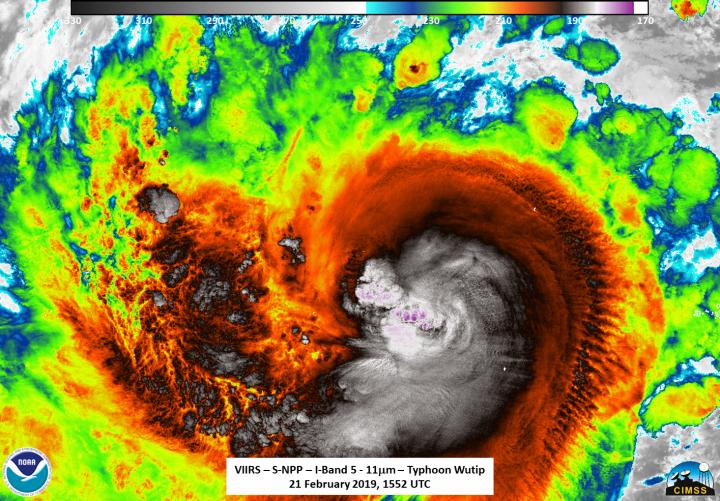
Credit: NASA/NOAA/Williams Straka III/UWM/CIMSS
Typhoon Wutip was impacting the Federated States of Micronesia in the Southern Pacific Ocean when NASA-NOAA’s Suomi NPP satellite passed overhead and analyzed the storm in infrared light.
On Feb. 22, the National Weather Service (NWS) in Tiyan, Guam noted that a Tropical Storm Warning remains in effect for Guam and Rota in the Mariana Islands and for Faraulep in Yap State. A Tropical Storm Watch also remains in effect for Tinian, Saipan, Pagan and Agrihan in the Commonwealth of the Northern Mariana Islands.
NASA-NOAA’s Suomi NPP satellite provided an infrared look at Typhoon Wutip on February 21 at 10:52 a.m. EDT (1552 UTC). William Straka III, of the University of Wisconsin-Madison, noted that the Visible Infrared Imaging Radiometer Suite (VIIRS) instrument aboard found Suomi NPP showed an intense cold region in the exact location of the overshooting cloud top observed in infrared, which just happens to be where the lightning streak was observed in other satellite imagery. In addition, it seemed to indicate some wrapping of the colder cloud regions around the inner circulation.
VIIRS showed storms around the center were as cold as or colder than 70 degrees (red) Fahrenheit (minus 56.6 degrees Celsius). NASA research has found that cloud top temperatures as cold as or colder than the 70F/56.6C threshold have the capability to generate heavy rainfall.
At 10 a.m. EDT/1500 UTC on Feb. 22 (1 a.m. CHST local time, Feb. 23) the eye of Typhoon Wutip was located by satellite at Latitude 10.1 degrees North and Longitude 144.7 degrees East and moving northwest at 15 mph. That’s about 105 miles north of Faraulep and about 230 miles south of Guam.
Wutip is expected to continue on a northwest track today and tonight with decreasing forward speed, then turn to a north-northwest course on Sunday and Monday. This track takes Wutip to a closest approach of about 160 miles southwest of Guam this evening. Maximum sustained winds have increased to 120 mph. Wutip is expected to maintain this intensity today, then begin a slow weakening trend tonight and Sunday.
Typhoon force winds extend outward up to 45 miles from the center, and tropical storm force winds extend out up to 185 miles.
The Joint Typhoon Warning Center forecast said Wutip will continue to track northwestward through February 24, before turning more north.
###
For updated forecasts, visit: https:/
By Rob Gutro
NASA’s Goddard Space Flight Center
Media Contact
Rob Gutro
[email protected]
Original Source
https:/



